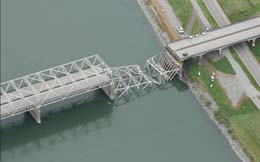On August 26, 1956, construction of the Primary State Highway 1 Skagit River Bridge just north of Mount Vernon in Skagit County is completed. It is a steel-truss bridge in four sections that enables the opening of a "limited access highway," a road that will, according to the Department of Highways newsletter, "remove the last major bottleneck between Seattle and Bellingham, making travel to Canada a real joy" ("Vacation in Western Washington"). Later this bridge will become part of Interstate 5. It will have served for nearly 57 years when, on May 23, 2013, after part of the northernmost truss is hit by an oversized load, one of the bridge's four spans will collapse into the river. A temporary span will be built and the bridge will reopen to traffic on June 19, 2013. A new permanent bridge will be put in place on September 15, 2013.
To Build a Bridge
The Skagit River Bridge was a steel through-truss bridge, one in which traffic drives through and under the truss. A truss is a tinker-toylike structure made of straight sticklike pieces riveted (in this case) together to make triangles. It is an open structure, which allows wind to blow through it as opposed to blowing it down. In a truss bridge there are two kinds of forces at work: compression (like two hands pressing together) and tension (like stretching a rubber band). These two forces are in balance so that the bridge can carry both its own weight (called the dead load) and the weight of traffic (called the live load).
The bridge was built by contractor Peter Kiewit Sons Co., of Longview, Washington. The contract was awarded on September 9, 1954, and the construction cost $1,328,461. Work began on September 21, 1954. The structure included four truss sections, supported by five piers, plus the approaches, each supported by four piers, with a total of 13 piers.
The bridge took almost a year longer to build than specified by the contract, due mainly to "extraordinarily severe weather conditions for both 1954 and 1955, with an unusual number of flooding stages in the Skagit River," according to a report submitted by Director of Highways William Adair Bugge (1900-1992); during most of February 1955, "blustery cold weather with rain and snow limited operations severely" (Bugge to Dixon, October 5, 1956).
The work involved building a large cofferdam, driving 13 piers, and building four sections of steel trusses. The trusses were assembled and riveted on the north bank of the river. They were then loaded onto a barge and set into place by derricks.
Once completed, the highway that crossed the bridge eased travel between Seattle and Bellingham. In the years following the Federal Aid Highway Act of 1956, which provided federal funds for a nationwide highway system, it became part of Interstate 5. It was a heavily traveled freeway and by 2010, more than 70,000 vehicles on average were crossing the Skagit River on the Interstate 5 bridge every day.
The Collapse
At about 7:00 p.m. on Thursday, May 23, 2013, after part of the truss structure was dinged by a tractor-trailer carrying an oversized load, the northernmost section of the bridge collapsed into the river. The driver drove his truck off the bridge only to see it falling into the river in his rear view mirror. Two vehicles went down with the bridge and three people were rescued. There were no serious injuries.
Craig Holstine, historian at the Washington State Department of Transportation (WSDOT) described what happened this way: "The truck's oversize load hit a sway brace that dislodged a vertical column, causing failure of the top chord and ultimately that span of the truss" (Holstine).
Following the collapse, Washington Governor Jay Inslee (b. 1951) declared a state of emergency in Skagit, Snohomish, and Whatcom counties, and the Washington State Department of Transportation rushed to award an emergency contract to have a temporary bridge in place within weeks as it began work on plans for a permanent replacement.
With the temporary span in place, the bridge re-opened on June 19, 2013. During the following months a new permanent concrete girder span was built on site. The temporary bridge was removed and the new span slid into place in one marathon night of bridgework, and the now permanent bridge reopened to traffic on September 15, 2013.

